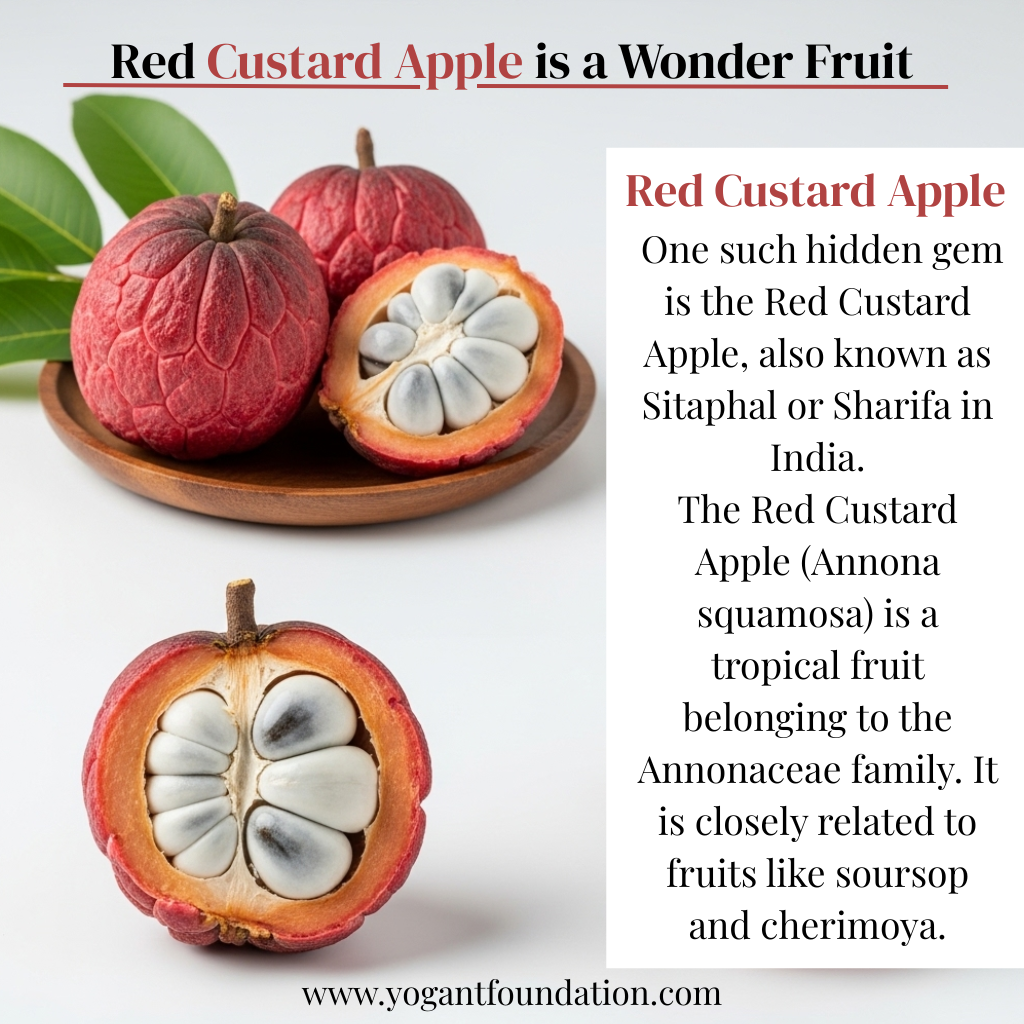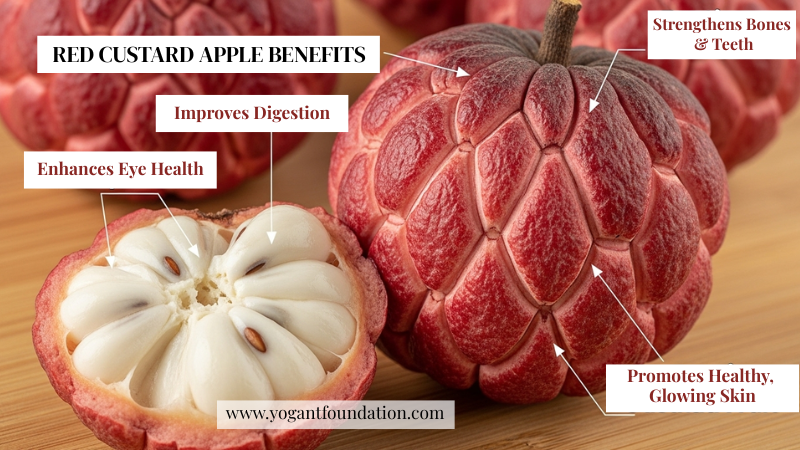Why Red Custard Apple is a Wonder Fruit
The world is full of fruits. Some are special because they have a unique taste, while others offer incredible health benefits. In India, the red custard apple is also called Sitaphal and Sharifa. The reddish pink skin of this strange fruit and its creamy custard-like pulp have been used in Ayurveda for centuries.
Red Custard Apple is Rare, Visually Striking, and Nutritionally Rich. Its soft and sweet pulp is packed with antioxidants, vitamins, minerals, and fiber. This fruit can boost immunity and promote glowing skin.
Sitaphal is a delicious fruit that melts in your mouth. The red version brings it to a whole new level. We’ll explore the reasons why you should include the Red Custard Apple in your fruit bowl.
What is Red Custard Apple?
Red Custard Apple is a tropical apple that belongs to the Annonaceae. The fruit is related to other fruits such as cherimoya and soursop. It is also known as Sitaphal and Sitaphal.
The Red variety is different from the green custard apples in that it has an attractive reddish-pink outer skin. The pulp inside is creamy white and soft with black glossy seeds. It has a delicious balance between sweetness and aroma, which is often likened to vanilla cream or custard.
In India, this fruit is found mainly in the winter and late monsoon seasons. Due to the increasing demand for this red variety, farmers and gardeners are cultivating it more.
Nutritional Value of Red Custard Apple (per 100 grams)
Red Custard Apples are not only delicious, they’re also a nutritional powerhouse. This is what one hundred grams of the fruit has to offer:
| Nutrient | Amount | Health Benefit |
| Calories | ~94 kcal | Provides instant energy |
| Carbohydrates | 23 g | Quick source of fuel |
| Protein | 2 g | Builds & repairs tissues |
| Fat | 0.5 g | Healthy, very low-fat fruit |
| Dietary Fiber | 4 g | Aids digestion & gut health |
| Vitamin C | 20 mg | Boosts immunity, skin glow |
| Vitamin B6 | 0.2 mg | Supports brain & mood balance |
| Folate (B9) | 14 mcg | Essential for pregnancy women |
| Potassium | 250 mg | Controls blood pressure |
| Magnesium | 18 mg | Strengthens bones & muscles |
| Iron | 0.7 mg | Prevents anemia |
| Calcium | 25 mg | Supports strong bones |
This nutrient profile makes it clear that the Red Custard Apple is not just another dessert fruit. It’s also a powerful natural remedy for your body.
15 Health Benefits from Red Custard Apple
1. Increases immunity naturally
Red Custard Apples are a powerful source of vitamin C, antioxidants, and other nutrients that support a healthy immune system. Consuming apples regularly helps to fight common infections, such as colds and flu. Antioxidants also reduce the chance of developing chronic disease by neutralizing harmful free radicals. Sitaphal can improve the body’s natural defense system when consumed during seasonal changes.
2. Improves Digestion & Gut Health
Red Custard Apple is a great source of dietary fibre. It helps to keep your digestion healthy. The apple acts as a laxative to prevent constipation and promote smooth bowel movements. The fiber also improves the health of your gut by feeding good bacteria. This fruit can help you if your stomach is acidic or indigestion.
3. Supports Heart Health
Red Custard apples are a great fruit to help with heart health. It is rich in magnesium and potassium. This fruit helps to regulate your blood pressure and keep your heartbeat stable. Dietary fiber and antioxidants reduce cholesterol. Sitaphal may lower the risk of strokes and heart attacks.
4. Controls Blood Pressure
Hypertension or high blood pressure is silently killing you. The potassium in Red Custard Apple relaxes blood vessels and improves blood flow. Magnesium regulates the heartbeat. These minerals work together to stabilize blood pressure naturally, so this is a fruit that’s safe for hypertension sufferers.
5. Good for Diabetic Patients
Custard apples are naturally sweet but have a lower glycemic index. It releases the sugar into your blood slowly, which prevents sudden spikes. Sitaphal is beneficial to people with diabetes when consumed in Moderation. Diabetic patients are advised to consult their doctor prior to consuming it on a regular basis.
6. Aids in Healthy Weight Gain
The Red Custard apple can help you regain weight if you’re underweight. Its high-calorie and carbohydrate contents provide quick energy and support healthy weight gain. Sitaphal, unlike processed food, contains natural sugars and vitamins, and minerals. Weight gain is safe and nutritious.
7. Improves Brain & Nerve Function
It is high in vitamin B6, which has a major role to play in the neurotransmitter system. This fruit improves your mood, decreases irritability, and increases focus. Magnesium calms down the nervous system and reduces stress-related disorders. Sitaphal may also improve memory and learning ability.
8. Strengthens Bones & Teeth
Red Custard Apples contain a balanced amount of Calcium, Magnesium, and Phosphorus. These minerals help build strong bones and prevent bone diseases such as osteoporosis. A regular intake of these minerals also helps to keep teeth strong and healthy. This is especially important for children growing up and older individuals.
9. Promotes Healthy, Glowing Skin
You can get naturally glowing skin by using Sitaphal. Sitaphal’s antioxidants, Vitamin C, and other ingredients are great for your skin. The antioxidants in Sitaphal fight free radicals and delay wrinkles. They also promote collagen. Sometimes, the creamy pulp can be used to make homemade masks that hydrate and brighten your skin.
10. Anti-Aging Properties
Red Custard Apple, with its antioxidant-rich profile, slows down ageing. This fruit helps in reducing fine lines, wrinkles, and age marks. The fruit is also a natural anti-aging treatment that keeps your skin elastic and youthful.
11. Great for Pregnancy Women
Ayurveda recommends Sitaphal for expectant mothers. It contains folate (Vitamin B9), iron, and calcium, which are vital for the growth of the fetus and the prevention of congenital disability. The fruit also reduces morning sickness and gives mothers instant energy.
12. Enhances Eye Health
Red Custard Apples have vitamins A and carotenoids, which help protect your eyes. Regular consumption of Red Custard Apple helps to improve vision.
13. Improves Hair Growth & Scalp Health
Nutrients such as vitamin C, iron, and magnesium increase blood circulation to the scalp. This promotes healthy hair growth. Sitaphal’s antioxidant properties protect the hair follicles, which reduces hair loss and premature graying.
14. Reduces Stress & Anxiety
Red Custard Apple has magnesium that acts as natural stress relief. It soothes nerves and aids in the regulation of cortisol. This fruit helps improve sleep, mood, and anxiety.
15. Detoxifies the Body
Fruits are naturally alkaline, and antioxidants help to flush toxins out of the body. The fruit helps the kidneys and liver in their detoxification process and maintains a healthy internal environment.

How to Eat and Use Red Custard Apple [Culinary & Ayurvedic Uses]
It’s not only healthy, but you can also enjoy the Red Custard Apple, or Sitaphal/Sharifa, in many different ways. This fruit is suitable for modern diets and traditional Ayurvedic treatments. It can be used to make rich desserts or to scoop out the pulp. Explore the different ways to eat this fruit and how you can use it.
1. Eating Red Custard Apple Raw
Raw Red Custard Apples are the easiest and most popular way to enjoy them. Wash it, slice it in half, and use a large spoon to scoop out the cream pulp. You don’t even need to add sugar because the sweetness of this fruit is intense. Remove the black seeds as they’re not edible. Raw food contains the most nutrients.
2. Red Custard Apple Smoothies & Shakes
Shakes, smoothies, and other drinks are popular ways to use Sitaphal. The creaminess of Sitaphal blends beautifully with milk and almond milk.
- Sitaphal Milkshake. Blend the pulp along with milk that has been chilled and some honey.
- Custard Smoothie: Combine pulp with banana, oatmeal, and almond milk for a powerful breakfast.
Drinks that will satisfy both adults and children.
3. Sitaphal Ice Cream & Desserts
In India, Sitaphal Ice Cream has become a favorite. It is frozen with condensed or cream milk to make a sweet, naturally sweet dessert. Red Custard Apple pulp can also be used in:
- Desserts
- Custards
- Pastries and cakes
- Fruit salads
Sharifa is a delicious fruit that makes a great dessert.
4. Red Custard Apple in Ayurveda
Ayurveda values Sitaphal’s nourishing and energizing properties. This is prescribed for balancing Pitta and Vata doshas. Ayurvedic use includes:
- To Restore Energy and Strength, eat the pulp.
- For Women Who Are Pregnant: Increases energy, decreases nausea, aids in fetal development.
- Skin Health. External application of pulp soothes and hydrates dryness.
- Digestion acts mildly laxative if consumed moderately.
Ayurvedic doctors also use dried custard apple powder as part of herbal formulas to promote overall health.
5. Red Custard Apple Seeds in Folk Remedies
Although seeds that have been detoxified are not safe to consume, the powdered seeds used in certain traditional remedies are externally applied for lice treatment and some skin ailments. This is only to be used under expert advice, as mishandling can lead to serious harm.
6. Modern Culinary Fusion
Red Custard Apple is being used by chefs in the modern kitchen. Some of the innovative recipes are:
- Sitaphal Cheesecake
- Custard apple popsicles
- Smoothie Bowls with Nuts and Seeds
- Cocktails/mocktails with Custard Apple Infusion
Slowly, this fruit has gained popularity in health-conscious households around the world.
Whether eaten raw, blended into a drink, or used in Ayurveda, the Red Custard Apple is a versatile treasure. It satisfies the taste buds and nourishes the body at the same time.
Precautions, Side Effects, and Things to Remember
While the Red Custard Apple has a lot of nutritional value and is good for your health, you should still consume it with caution. Side effects can occur from overeating the fruit or using it incorrectly. Explore the important precautions:
1. High Natural Sugar Content
Red Custard Apples are naturally sweet and contain a lot of fructose. Although it is a great energy fruit for people with Diabetes, they should consume it in Moderation. A high blood sugar level can be caused by eating too much. Sitaphal may be included regularly in diabetic diets, but it is important to consult a doctor.
2. Risk of Weight Gain
Red Custard apple may be a bad choice if you’re trying to lose some weight. Eating large amounts of this fruit can cause unwanted weight gain. For people who want to gain some weight, it can actually be a positive.
3. Seeds are Inedible and Toxic
The seeds are not edible. The seeds contain toxic natural compounds. It is not dangerous to accidentally swallow one or two small seeds, but it can be harmful if you eat them on purpose. Although the seeds can be used in some traditional remedies to treat external ailments, they should never be consumed.
4. Possible Stomach Discomfort
If you eat too many Red Custard apples in one go, it can lead to digestion issues, such as mild diarrhea, bloating, or gas. It is due to the high amount of fiber and sugar found in this fruit. The key is Moderation.
5. Not Suitable for Cold-Prone People
Ayurveda considers custard apples to be a cooling apple. It is best to avoid it if you are prone to colds or coughs.
6. Allergic Reactions (Rare)
After consuming the custard apples, some people may develop mild allergies such as itching and skin rashes. If you experience any of these symptoms, it is best to discontinue the use of custard apple and contact a medical professional.
7. Interaction with Certain Medications
Custard apples help lower blood pressure. People who are taking antihypertensive medications may want to consult with their doctor prior to taking them daily. Potassium excess can interact with these drugs.
FAQs about Red Custard apple
Q1. What’s the difference between a red custard and a green one?
Their looks are the main differences. Red custard apples have a pinkish-red outer skin, while Green Custard Apple varieties are light green. The red custard apple is rarer and has a slightly stronger flavor. Both are nearly identical in terms of nutrition.
Q2. Is Sitaphal (Sharifa) good for diabetes?
Yes. But in moderate amounts. Sitaphal is low in glycemic load, which means it slowly releases sugar into the bloodstream. Diabetic patients are advised to limit their intake due to its high sugar content.
Q3. Can pregnancy women eat Red Custard Apple?
Yes. In fact, Ayurveda recommends Sitaphal during pregnancy. This product contains iron, folate, calcium, and Vitamin B6, which help to reduce morning sickness and support fetal growth. It should only be consumed in small amounts to prevent excess sugar.
Q4. Is custard apple good for weight loss or weight gain?
The custard apple has a higher calorie and energy density, which makes it more suitable for weight gain. Small portions can be fine for people who are trying to lose some weight. However, overeating may cause you to gain weight.
Q5. Does Red Custard Apple cause a cold or a cough?
Yes, for some people. Ayurveda advises against excessive Sitaphal consumption in winter, as it is a fruit that cools.
Q6. How do I know if a Red Custard Apple is ripe?
When pressed, a ripe Red Custard Apple will feel soft. The outer skin cracks and segments may be more visible. Fruits that are unripe or too mushy should be avoided.
Q7. Can a custard apple be eaten at night?
Sitaphal is good, but you should eat it earlier rather than later in the evening. It is rich in fiber and natural sugars, so eating it too close to bedtime can cause mild bloating.
Q8. Are custard apple seeds poisonous?
No. The seeds of custard apples should not consumed as they are toxic. In some traditional remedies, the seeds can used as an external remedy after detoxification.
Q9. Can children eat Red Custard Apple?
No. Sitaphal, a natural sweetener, is suitable for children. This natural sweetener is a healthy alternative to sugary processed foods. You should remove the seed carefully before feeding it to your kids.
Q10. How often can I eat Red Custard Apple?
Three to four times per week is fine for most people who are healthy. If you have diabetes or are over-weight, your doctor may advise that you limit the amount of fruit.
Conclusion : The sweet gift of nature
The Red Custard apple (Sitaphal/Sharifa) is not just an amazing fruit; it’s a Superfood full of nutrients, antioxidants, and natural energy. This fruit is good for almost all aspects of health. It can boost immunity, improve digestion, support heart health and pregnancy, as well as skin and hair growth.
Sitaphal, unlike many superfoods, which are hard to come by and expensive, is grown locally in India. It can be enjoyed at any time of the year. It is rare and unique to find the variety with its pinkish-red skin, rich taste, and attractive appearance.
The Red Custard Apple can eaten raw, blended into smoothies, enjoyed as Sitaphal Ice Cream, or used in Ayurveda.
Consume it moderately, don’t eat the seeds, and only eat it when the season is right. Add this fruit to your diet if you want to boost your immunity and your skin’s glow naturally.
You should not miss this opportunity the next time you encounter a Red Apple with Custard.


